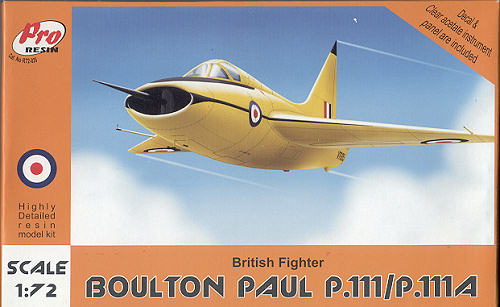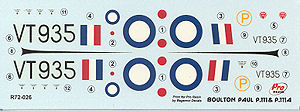
| KIT: | ProResin 1/72 Boulton Paul P.111 |
| KIT #: | R72-026 |
| PRICE: | $ |
| DECALS: | One option |
| REVIEWER: | Scott Van Aken |
| NOTES: | Resin kit with vacuformed canopy |

| HISTORY |
In the late 1940ís and early 1950ís the British aircraft industry was engaged in many projects to confirm and develop the design ideas captured from the Germans at the end of the second world war. As part of this activity the P111 was built for the Air Ministry to specification E.27/46 by Boulton Paul Aircraft Ltd to investigate the possibilities of the delta planform wing. It was also the first to be designed purely for research into the properties of the delta wing, as touted by Alexander Lippisch.
The P111 was designed to be the smallest airframe which could couple an engine, a Rolls-Royce Nene, an ejector seat (Martin Baker), and a delta wing. The latter could be fitted with a variety of extensions to investigate different tip profiles. The construction was all metal with the exception of the wing extensions which were of fiberglass.
The aircraft was not designed to be supersonic but to explore the characteristics of the aircraft shape in the transonic speed range.
The P.111 made its first flight on the 10 October 1950, at Boscombe Down with Squadron Leader Bob Smyth at the controls. Later test flying was carried out by the legendary test pilot, Alexander "Ben" Gunn, who described the aeroplane as "touchy" and "like flying a razors edge". The aircraft was extremely unstable longitudinally and could easily go into pilot induced oscillations. Because of this, and its bright colour scheme, the P.111 became known as the "Yellow Peril" - a pun on the nickname used for the Japanese threat during the war.
After a wheels-up landing the P.111 was modified to improve the flight characteristics, and re-appeared in its new guise as the P111a. In this guise, it flew again in July 1953. Airbrakes were found to be very effective but landing speeds were still very high. This was before aerodynamic braking, a technique that was used to help slow other delta aircraft such as the F-102 and Mirage III series. Still the addition of a braking parachute was deemed to be a requirement and the anti-spin chute was strengthened to be used in this manner.
After a last flight in 1958 it went to Cranfield. From there it was transferred to the Midlands Aircraft Preservation Society at Baginton, Coventry, where the P111a is currently exhibited. The P.111 was followed by the P.120 another delta-winged experimental craft.
| THE KIT |
 Previous to this kit, there were a couple of other P.111a versions done. One by Merlin Models that was a horrendous lump that could be made into what passed for this aircraft. I think that there was a resin kit as well, but the name of the company escapes me at the moment. Needless to say, this is by far the best one done and will be hard to surpass.
Previous to this kit, there were a couple of other P.111a versions done. One by Merlin Models that was a horrendous lump that could be made into what passed for this aircraft. I think that there was a resin kit as well, but the name of the company escapes me at the moment. Needless to say, this is by far the best one done and will be hard to surpass.
Molded in a tan resin, the level of detail is really superb. It includes not only engraved panel lines, but nicely done depressed rivet detail . The kit is also absent of most flaws that can occur with resin kits. Only on the wing and tail leading edge next to the pour stub did I find any pin holes and then only a very few. There is also a slight depression on one upper wing over the gear mount. I found that there were detailed gear wells and nicely done landing gear. Thanks to their shortness there should be no worries about resin deformation over the years.
The cockpit tub is very nicely appointed with detailed side consoles and instrument panel. A nicely done bang seat is provided and ProResin gives good painting instruction for this area. The nose gear makes up of a separate strut and nose wheel fork. I personally wish things like this would be molded in one piece as I often have trouble getting all to stick.
You are given two intake sections for the P.111 or P.111a. You also have to cut the wing tips and attach the short tips that are provided if you wish to model the P.111. There are a few small parts that will require care to remove from the stub without breaking them. A single vacuformed canopy is provided. While most will be able to get the one to work fine, I always like to have two so when I mess up the original, there is a back up. It is just a piece of mind thing. Nose weight is indicated in  the instructions but no how much. Plenty of room is provided for however much you wish to add.
the instructions but no how much. Plenty of room is provided for however much you wish to add.
Instructions are quite well done with a history section, parts layout, and five well drawn construction steps. Color information is provided in the sequences and a reference in Humbrol, ModelMaster and Revell paints is given. There is a nicely done decal sheet with markings for one plane. The P.111 is in overall unpainted metal from its first flight. The P.111a is in yellow as flown in 1953. Decals are nicely printed and seem to be in register.
| CONCLUSIONS |
ProResin kits are superbly molded and I'm pleased to see that they are going into the realm of British research aircraft. Little has been done in this area and the P.111 is a great way to get involved in the genre. This is the sort of kit that would be a perfect introduction to resin kits in general. It provides superb detail, yet doesn't overwhelm one with a plethora of small parts. When you see it; get it.
October 2006
| REFERENCES |
My thanks toProResin for the review kit.
for the review kit.
If you would like your product reviewed fairly and quickly by asite that has over 325,000 visitors a month, please contactme or see other details in the
Back to the Previews Index Page
Pro Resin 1/72 P.111 ProResin 1/72 P.111 ProResin 1/72 P.111 ProResin 1/72 P.111